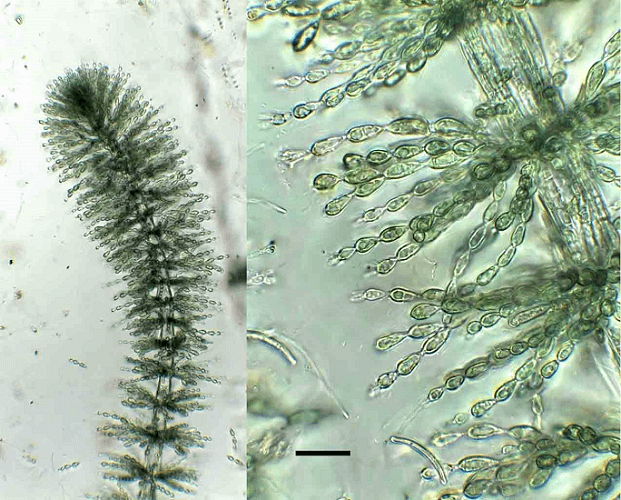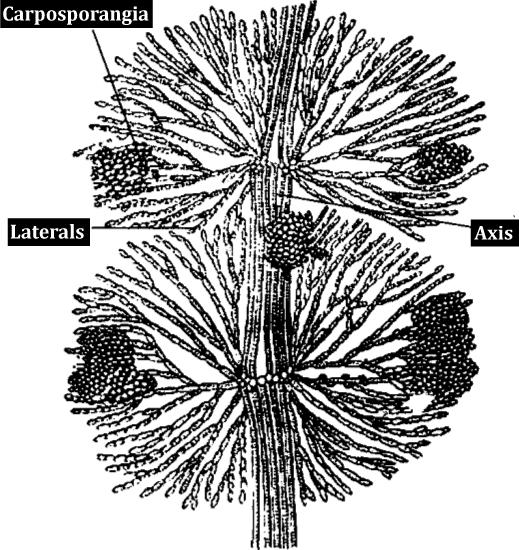BatrachospermumA particular species of green algae called Batrachospermum can be found in watery environments. Its basic form is that of a single cell with a nucleus and a chloroplast. Algae can synthesise oxygen and organic compounds from sunlight thanks to the photosynthetic pigments found in their chloroplast. The algae known as Batrachospermum also have a cell wall and cytoplasm, which houses organelles like mitochondria. 
Basic OrganisationAs the main producers of organic matter in aquatic ecosystems, algae are immensely significant. They can range in size from microscopic cells to gigantic kelp that can grow up to 200 feet long, and they can be found in both freshwater and marine habitats. Algae come in a wide range of varieties, each with a unique shape and structure. Different forms of algae consist of single cells and cell colonies. Some varieties of algae have a rigid cell wall, whilst others have a flexible and gelatinous wall. Algae can be green, red, or brown, among other colours. Algae of certain species include photosynthetic pigments that give them their distinctive colour. Algae are often relatively basic organisms made up of just a single cell or a small group of cells. Their cells are often shaped like circular or oval and lack a real nucleus or organelles. Aquatic ecosystems depend on algae since they are the main producers of organic materials. They create food for other aquatic animals and contribute to the ecosystem's stability by absorbing nutrients and creating habitats for other organisms. Classification of BatrachospermumRed algae that are generally found in freshwater habitats belong to the Batrachospermum class. These algae can form huge colonies and are typically filamentous. Some marine species are included in the Batrachospermum class. OccurrenceRed algae called Batrachospermum can be found in freshwater environments. These algae can be found in many different types of water bodies, such as ponds, ditches, and slow-moving streams. It is a typical element of benthic communities. In quiet, well-lit places, it often appears as a tiny, red filament that can grow into vast colonies. Given that it is a significant source of food for aquatic invertebrates, this alga plays a significant role in the food chain. Additionally, it offers fish and other aquatic organisms vital habitat. Additionally, water filtration and remediation can be accomplished using Batrachospermum algae. The distribution and abundance of Batrachospermum algae can be influenced by a number of factors. These include nutritional concentrations, light accessibility, and water temperature. Physical disturbances like wave activity or rushing water can also affect the algae. Overall, the algae known as Batrachospermum is an essential component of aquatic ecosystems and a key component of the food chain. It serves as a crucial habitat for fish and other aquatic organisms, as well as a crucial food source for aquatic invertebrates. It can also be applied to water filtering and clean-up. Vegetative StructureThe vegetative structure of a plant is what allows it to absorb water and sunlight and convert it into food and energy. The stem, leaves, and roots make up the vegetative structure. The stem is in charge of holding the leaves in place and delivering nutrients and water to the leaves. The sunlight is captured and converted into energy by the leaves. Water and nutrients from the soil are taken up by the roots. From the Nodes, the Two Groups of BranchesThe larger group and the smaller group are the two groupings of branches that emerge from the nodes. In contrast to the smaller group, which is thinner and has fewer leaves, the larger group of branches is thicker and has more leaves. Additionally, the larger branch cluster is situated higher on the tree than the smaller cluster. Cellular ComponentsThe smallest unit of life is a cell. Only a microscope can see cells because they are so tiny. Cytoplasm, the nucleus, and the cell membrane are the three components that make up a cell. The jelly-like substance found inside a cell is called cytoplasm. It has the organelles of the cell, which are the entities responsible for carrying out the functions of the cell. The brain of the cell is the nucleus. The DNA of the cell, which houses the genetic code for the cell, is contained in it. The cell's exterior is made up of the cell membrane. It guards the cell and regulates what goes in and out. Growth
Reproduction with Batrachospermum

FertilisationThe spermatium lands on the trichogyne's surface. The trichogyne's wall dissolves, allowing the sperm's nucleus to enter the carpogonium. It joins the female nucleus to create the zygote. Germination Four nuclei separate from the zygote nucleus. Reduction division comes first.
Life Cycle of the BatrachospermumThe non-motile spermatia float in the water. A high number of spermatia approach the trichogyne. One of the spermatia has the trichogyne attached. One of the two spermatium nuclei passes through this opening in the contact wall to the trichogyne, where it joins with the female egg and forms the zygote in the basal swelling area of the carpogonium. The trichogyne then contracts until it encounters the slit between the trichogyne and the carpogonium. At this step, a cross-wall develops concurrently. Germination of the ZygoteThe zygote's diploid nucleus splits into two haploid nuclei during meiosis. One of the two nuclei then moves into the lateral protrusion of the zygote. The gonimoblast initial has the form of this protrusion, which is walled off from the remainder of the zygote. As a consequence of the other daughter nucleus's repeated divisions, there are a lot of gonimoblast initials. The terminal cells of a branching gonimoblast develop into carposporangia as the gonimoblast grows. Each carposporangium produces a single, rounded haploid carpospore that is distinct from the others. The gonimoblast filaments, carposporangia, and carpospores make up the cystocarp or carposporophyte.
Next TopicBrain Structure
|
 For Videos Join Our Youtube Channel: Join Now
For Videos Join Our Youtube Channel: Join Now
Feedback
- Send your Feedback to [email protected]
Help Others, Please Share









